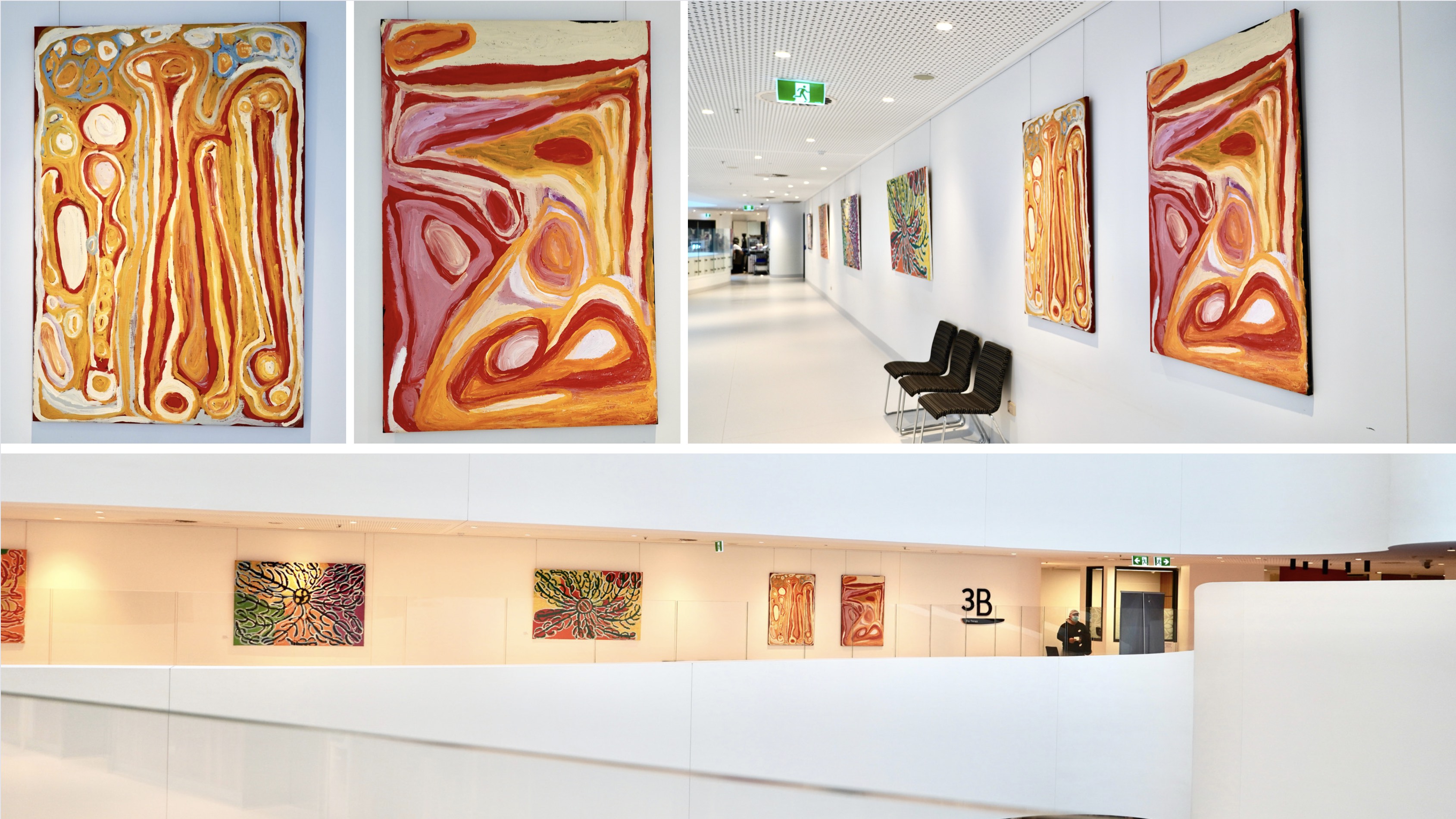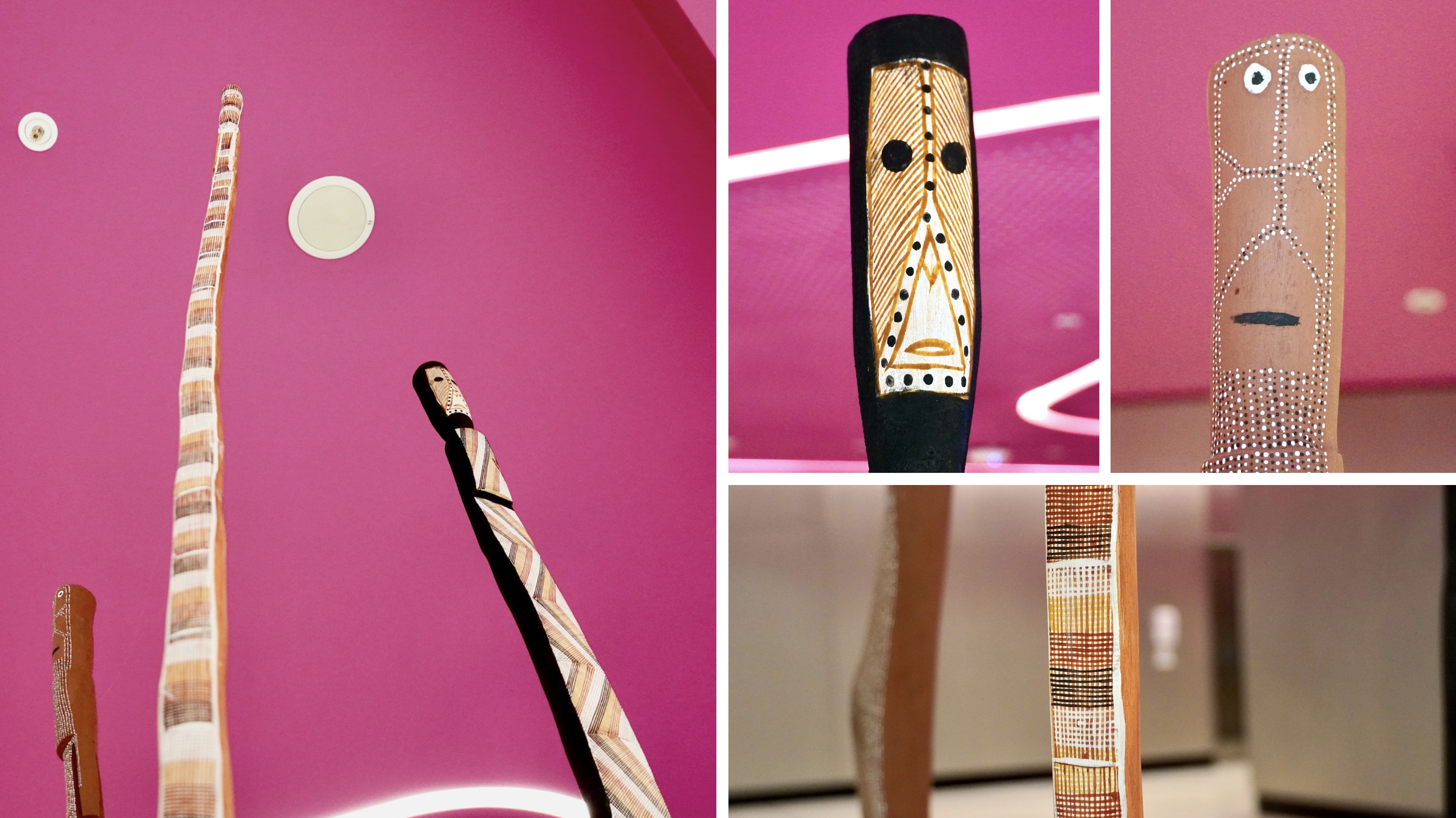New art unveiled for NAIDOC Week
5 min read 03 July 2023
In celebration of NAIDOC Week, we’ve added some exciting new works to Peter Mac’s Aboriginal art collection.
NAIDOC is all about recognising the history, culture and achievements of the oldest, continuous living culture on earth.
Art is a huge part of that as it carries stories, traditions and spiritual significance - ensuring that future generations can learn about and appreciate the artistic and cultural traditions of First Nations peoples.
Peter Mac has an extensive collection from First Nations artists which not only inject colour into the building but is a visual reminder of the enduring presence and resilience of Aboriginal and Torres Strait Islander people.
We’re incredibly excited to unveil the significant new works to the collection, all generously donated through the Australian Government’s Cultural Gifts Program.
Check out photos of the artwork and read about the artists below.

Kulu Alu (2013) by Sallyanne Roberts
Location: Level 3 near clinic 3C.
Sallyanne Roberts began painting at the Tjungu Palya art centre in the small community of Nyapari, deep in the Pitjantatjara desert, the very heart of the APY lands. One of a new generation of painters from this area, she was nurtured and encouraged by her grandmother Kunmanara (Wingu) Tingma, a senior law woman, traditional healer and celebrated painter.
As Sallyanne has said of her grandmother”….when she was getting very old, she taught me her stories and how to paint them in our special family’s way. She taught me how to paint the pictures of Kuru Ala country, it’s a special place just for women”
Kuru Ala is a sacred place for the Kungkarrakalpa (Seven Sisters Creation Story), a space for special “inma” (ceremonies) and a place for healing. It is the focus of many of Sallyanne’s paintings and is the subject of this work, “Kuru Alu, 2013”.
The painting depicts the journey of the travelling sisters who are gathering food and taking advantage of the many waterholes in this country. They are being watched by a dangerous man Wati Nyiru and hide in a cave, dancing all night in a special ceremony. The long lines and shapes in the painting depict the dancing tracks they have left behind while the red and white shape denotes the sacred women’s place.
Rendered in a rich palette of reds, orange and darker accents combined with sensuous linear elements, in this vivid rendition the artist has created a compelling layered and textured work, replete with meaning and visual interest.
Donated through the Australian Government’s Cultural Gifts Program by Jim Cousins AO and Libby Cousins AM.

Kunawarritji (2011) by Nora Wompi
Liburu (2011) Nora Nganapa
Location: Level three near clinic 3B
Connection to the land and cultural stories embedded within the landscape is central to the work of Aboriginal artists Nora Wompi and Nora Nganapa. These two women who shared a grandfather were connected by skin, country and circumstance and their art and lives were intrinsically entwined. Sharing a history shaped by the intrusion of the Canning Stock Route on their traditional lands and way of life, they were from the generation of Aboriginal people in the Kimberley who grew up in the desert and came to old Balgo mission with their families seeking refuge. Nomadic life was harsh and even more so during the prolonged and severe drought in the western desert during the 1960s.
Both Wompi and Nganapa painted their traditional country near Kunawarritji, ( Well 33) along the middle stretches of the Canning Stock Route. Their fluid brushstrokes capture dreaming sites, talis (sandhills), soak holes and bush tucker, creating works that reflect their intimate knowledge and spiritual connection to their country, bringing the Great Sandy Desert alive in their art. For many years the two women painted alongside each other.
In Wompi’s Kunawarritji, 2013, sensuous linear elements in the painting represent the tali that dominate this country and are delineated with multiple thick lines. The circular shapes which are rendered with circles of colour, represent rock or soak holes, important sources of water dotted throughout the desert where bush foods including bush tomato and bush raisins are abundant.
Nora Nganapa’s works are highly contemplative and her deliberate application of strokes of colour in a restricted palette are applied with measured assurance. The strong shapes of yellow, red, ochre and green capture the features and stories of Kunawarritji in this painting, Liburu, 2013. Here the central circle represents a significant rock hole, Liburu, near where the artist was born, while the painting tells the story of two snakes who were living in the rock hole and about their journey as they travelled through the sandhills of this region. The linear elements refer to the journey and trees growing in the area.
Donated through the Australian Government’s Cultural Gifts Program in memory of Patricia Anne Bevan.

Mimih Spirits (2001/2002) by Crusoe Kurdall, Timothy Wulanjibirr and Melba Gunjarrwanga
Location: Ground floor, near the research lifts
Three sculptures from the Peter Mac Art Collection, created by significant indigenous artists Crusoe Kurdall, Timothy Wulnjibirr and Melba Gunjarrwanga, working in Maningrida in central Arnhem Land have been placed in the foyer.
These were recently intalled at the Parkville campus having previously been on display at Peter Mac East Melbourne.
They portray a sculptural representation of the mythological Mimih Spirits and have been carved and painted in natural ochres, featuring delicate cross hatching known as raark, ceremonial body designs and scarification marks.
Indigenous people believe that Mimih Spirits live in a social organisation similar to theirs, which however predated their own. They credit them with teaching their ancestors how to survive. While the Mimihs are generally thought to be benign toward humans, sometimes they are attributed with mischievous and dangerous qualities as well.
It is said that Mimihs are shy and flee when approached by strangers, blowing on rocks which open and allow them to seek shelter. As Mimihs are extremely slender and tall, it is thought that strong winds can damage their bodies and therefore, they prefer to emerge on windless nights.
Indigenous people also believe that some tribal magicians or ‘clever men” can develop intimate relationships with Mimih Spirits who then initiate them into the secret knowledge of ritual songs and dances, also revealing the location of sacred places.
Donated through the Australian Government’s Cultural Gifts Program by Gabrielle Pizzi.
